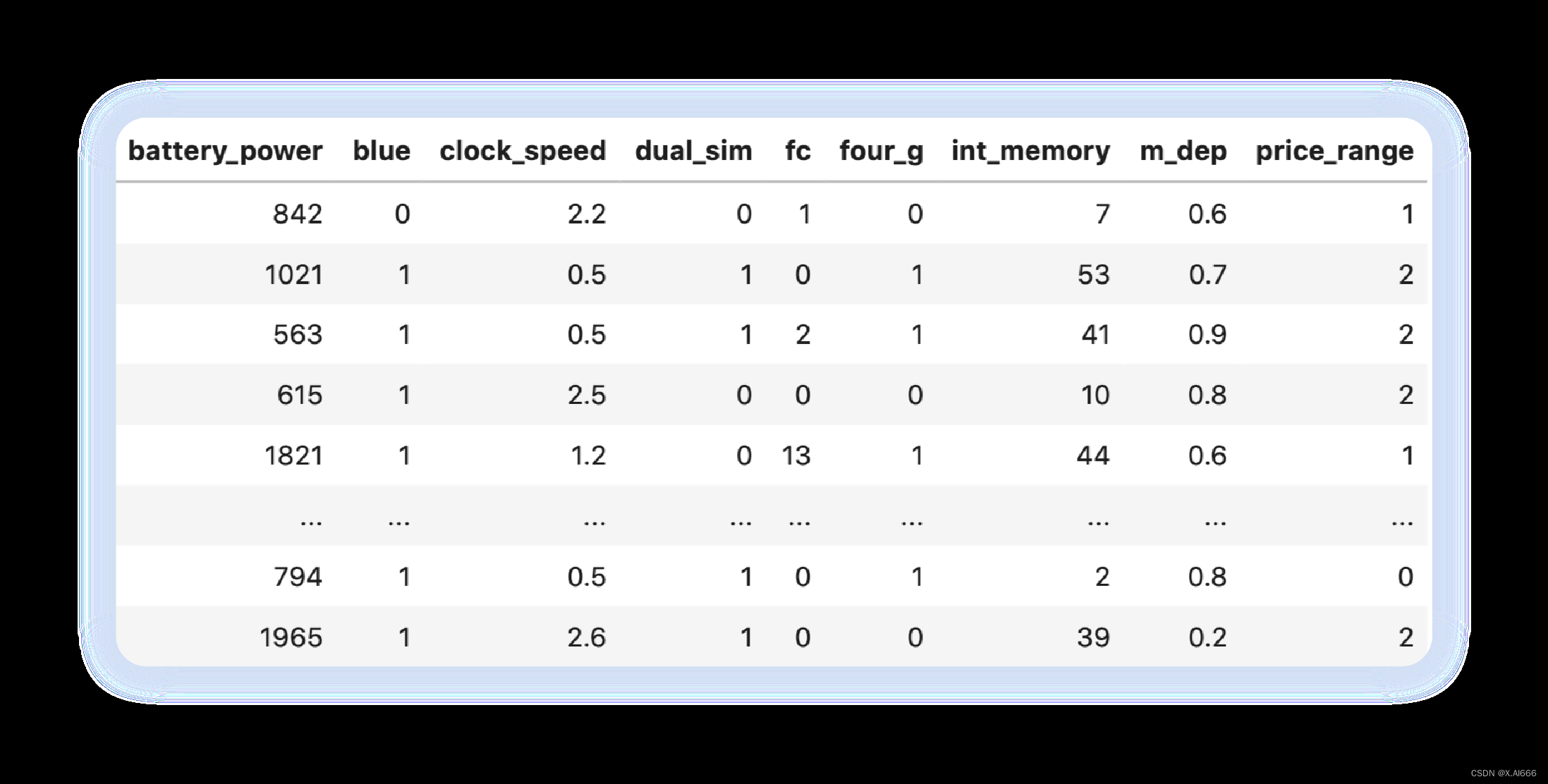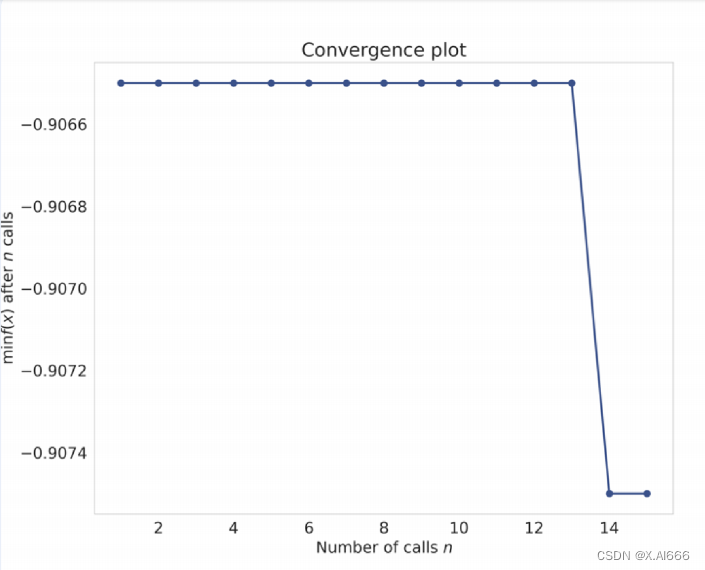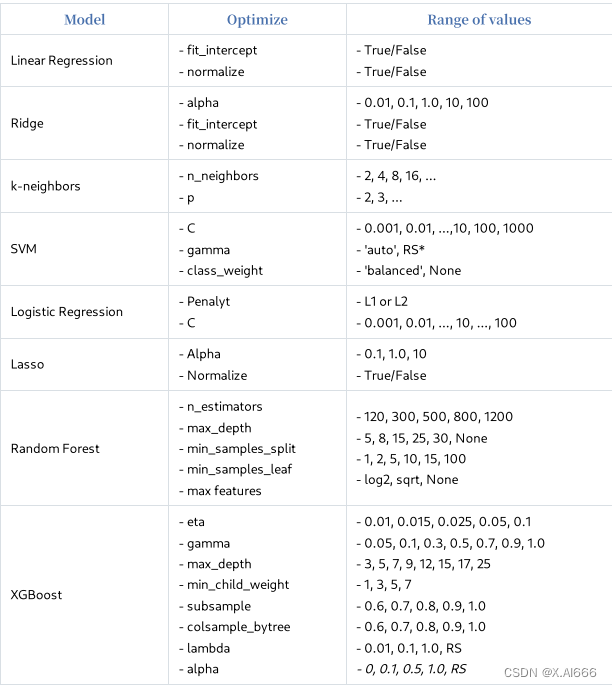热门标签
热门文章
- 1在 Linux 下搭建 Git 服务器_linux git 服务器
- 2《Python工匠》学习笔记----第四章:条件分支控制流_第四课 条件分支控制流
- 3人间词话_死人又生性,也是一生似乎钱
- 4关于YOLOv5的训练,GPU单卡、多卡设置,加速训练_yolov5 多卡训练
- 5游戏攻略网站设计与实现 毕业设计-附源码96153_关于游戏攻略毕业设计
- 6C语言 AF_UNIX tcp/udp socket实例_udp af unix
- 7商密圈大咖齐聚北京 共商国密开源未来发展方向_openssl 3.0 sm2
- 8基于springboot+vue的家政服务系统(前后端分离)_基于springboot vue家政服务预约平台系统
- 9TCP 连接的建立 & 断开
- 10LLDB(二):基础命令详解_lldb attach
当前位置: article > 正文
【解决(几乎)任何机器学习问题】:超参数优化篇(超详细)
作者:IT小白 | 2024-02-19 21:05:05
赞
踩
【解决(几乎)任何机器学习问题】:超参数优化篇(超详细)
这篇文章相当长,您可以添加至收藏夹,以便在后续有空时候悠闲地阅读。
有了优秀的模型,就有了优化超参数以获得最佳得分模型的难题。那么,什么是超参数优化呢?假设您的机器学习项⽬有⼀个简单的流程。有⼀个数据集,你直接应⽤⼀个模型,然后得到结 果。模型在这⾥的参数被称为超参数,即控制模型训练/拟合过程的参数。如果我们⽤ SGD 训练线性回归,模型的参数是斜率和偏差,超参数是学习率。你会发现我在本章和本书中交替使⽤这些术语。假设模型中有三个参数 a、b、c,所有这些参数都可以是 1 到 10 之间的整数。这些参数 的 "正确 "组合将为您提供最佳结果。因此,这就有点像⼀个装有三拨密码锁的⼿提箱。不过,三拨密码锁只有⼀个正确答案。⽽模型有很多正确答案。那么,如何找到最佳参数呢?⼀种⽅法是对所有组合进⾏评估,看哪种组合能提⾼指标。让我们看看如何做到这⼀点。
- best_accuracy = 0
- best_parameters = {"a": 0, "b": 0, "c": 0}
- for a in range(1, 11):
- for b in range(1, 11):
- for c in range(1, 11):
- model = MODEL(a, b, c)
- model.fit(training_data)
- preds = model.predict(validation_data)
- accuracy = metrics.accuracy_score(targets, preds)
- if accuracy > best_accuracy:
- best_accuracy = accuracy
- best_parameters["a"] = a
- best_parameters["b"] = b
- best_parameters["c"] = c
在上述代码中,我们从 1 到 10 对所有参数进⾏了拟合。因此,我们总共要对模型进⾏ 1000 次(10 x 10 x 10)拟合。这可能会很昂贵,因为模型的训练需要很⻓时间。不过,在这种情况下应 该没问题,但在现实世界中,并不是只有三个参数,每个参数也不是只有⼗个值。 ⼤多数模型参 数都是实数,不同参数的组合可以是⽆限的。
让我们看看 scikit-learn 的随机森林模型。
- RandomForestClassifier(
- n_estimators=100,
- criterion='gini',
- max_depth=None,
- min_samples_split=2,
- min_samples_leaf=1,
- min_weight_fraction_leaf=0.0,
- max_features='auto',
- max_leaf_nodes=None,
- min_impurity_decrease=0.0,
- min_impurity_split=None,
- bootstrap=True,
- oob_score=False,
- n_jobs=None,
- random_state=None,
- verbose=0,
- warm_start=False,
- class_weight=None,
- ccp_alpha=0.0,
- max_samples=None,
- )

有 19 个参数,⽽所有这些参数的所有组合,以及它们可以承担的所有值,都将是⽆穷⽆尽的。通常情况下,我们没有⾜够的资源和时间来做这件事。因此,我们指定了⼀个参数⽹格。在这个⽹格上寻找最佳参数组合的搜索称为⽹格搜索。我们可以说,n_estimators 可以是 100、200、250、300、400、500;max_depth 可以是 1、2、5、7、11、15;criterion 可以是 gini 或 entropy。这些参数看起来并不多,但如果数据集过⼤,计算起来会耗费⼤量时间。我们可以像之前⼀样创建三个 for 循环,并在验证集上计算得分,这样就能实现⽹格搜索。还必须注意的是,如果要进⾏ k 折交叉验证,则需要更多的循环,这意味着需要更多的时间来找到完美的参数。因此,⽹格搜索并不流⾏。让我们以根据
⼿机配置预测⼿机价格范围
数据集为例,看看它是如何实现的。

图
1
:⼿机配置预测⼿机价格范围数据集展⽰
训练集中只有 2000 个样本。我们可以轻松地使⽤分层 kfold 和准确率作为评估指标。我们将使⽤ 具有上述参数范围的随机森林模型,并在下⾯的⽰例中了解如何进⾏⽹格搜索。
- # rf_grid_search.py
- import numpy as np
- import pandas as pd
- from sklearn import ensemble
- from sklearn import metrics
- from sklearn import model_selection
-
- if __name__ == "__main__":
- df = pd.read_csv("./input/mobile_train.csv")
- X = df.drop("price_range", axis=1).values
- y = df.price_range.values
-
- classifier = ensemble.RandomForestClassifier(n_jobs=-1)
- param_grid = {
- "n_estimators": [100, 200, 250, 300, 400, 500],
- "max_depth": [1, 2, 5, 7, 11, 15],
- "criterion": ["gini", "entropy"]
- }
-
- model = model_selection.GridSearchCV(
- estimator=classifier,
- param_grid=param_grid,
- scoring="accuracy",
- verbose=10,
- n_jobs=1,
- cv=5
- )
-
- model.fit(X, y)
- print(f"Best score: {model.best_score_}")
- print("Best parameters set:")
- best_parameters = model.best_estimator_.get_params()
- for param_name in sorted(param_grid.keys()):
- print(f"\t{param_name}: {best_parameters[param_name]}")

这⾥打印了很多内容,让我们看看最后⼏⾏。
[ CV ] criterion = entropy , max_depth = 15 , n_estimators = 500 , score = 0.895 ,total = 1.0 s[ CV ] criterion = entropy , max_depth = 15 , n_estimators = 500 ...............[ CV ] criterion = entropy , max_depth = 15 , n_estimators = 500 , score = 0.890 ,total = 1.1 s[ CV ] criterion = entropy , max_depth = 15 , n_estimators = 500 ...............[ CV ] criterion = entropy , max_depth = 15 , n_estimators = 500 , score = 0.910 ,total = 1.1 s[ CV ] criterion = entropy , max_depth = 15 , n_estimators = 500 ...............[ CV ] criterion = entropy , max_depth = 15 , n_estimators = 500 , score = 0.880 ,total = 1.1 s[ CV ] criterion = entropy , max_depth = 15 , n_estimators = 500 ...............[ CV ] criterion = entropy , max_depth = 15 , n_estimators = 500 , score = 0.870 , total = 1.1 s[ Parallel ( n_jobs = 1 )]: Done 360 out of 360 | elapsed : 3.7 min finishedBest score : 0.889Best parameters set :criterion : 'entropy'max_depth : 15n_estimators : 500
最后,我们可以看到,5折交叉检验最佳得分是 0.889,我们的⽹格搜索得到了最佳参数。我们可 以使⽤的下⼀个最佳⽅法是
随机搜索
。在随机搜索中,我们随机选择⼀个参数组合,然后计算交 叉验证得分。这⾥消耗的时间⽐⽹格搜索少,因为我们不对所有不同的参数组合进⾏评估。我们 选择要对模型进⾏多少次评估,这就决定了搜索所需的时间。代码与上⾯的差别不⼤。除了GridSearchCV 外,我们使⽤ RandomizedSearchCV。
- if __name__ == "__main__":
- classifier = ensemble.RandomForestClassifier(n_jobs=-1)
- param_grid = {
- "n_estimators": np.arange(100, 1500, 100),
- "max_depth": np.arange(1, 31),
- "criterion": ["gini", "entropy"]
- }
- model = model_selection.RandomizedSearchCV(
- estimator=classifier,
- param_distributions=param_grid,
- n_iter=20,
- scoring="accuracy",
- verbose=10,
- n_jobs=1,
- cv=5
- )
- model.fit(X, y)
- print(f"Best score: {model.best_score_}")
- print("Best parameters set:")
- best_parameters = model.best_estimator_.get_params()
- for param_name in sorted(param_grid.keys()):
- print(f"\t{param_name}: {best_parameters[param_name]}")

我们更改了随机搜索的参数⽹格,结果似乎有了些许改进。
Best score : 0.8905Best parameters set :criterion : entropymax_depth : 25n_estimators : 300
如果迭代次数较少,随机搜索⽐⽹格搜索更快。使⽤这两种⽅法,你可以为各种模型找到最优参 数,只要它们有拟合和预测功能,这也是 scikit-learn 的标准。有时,你可能想使⽤管道。例如假设我们正在处理⼀个多类分类问题。在这个问题中,训练数据由两列⽂本组成,你需要建⽴⼀个模型来预测类别。让我们假设你选择的管道是⾸先以半监督的⽅式应⽤ tf-idf,然后使⽤SVD 和SVM 分类器。现在的问题是,我们必须选择 SVD 的成分,还需要调整 SVM 的参数。下⾯的代段展⽰了如何做到这⼀点。
- import numpy as np
- import pandas as pd
- from sklearn import metrics
- from sklearn import model_selection
- from sklearn import pipeline
- from sklearn.decomposition import TruncatedSVD
- from sklearn.feature_extraction.text import TfidfVectorizer
- from sklearn.preprocessing import StandardScaler
- from sklearn.svm import SVC
-
- def quadratic_weighted_kappa(y_true, y_pred):
- return metrics.cohen_kappa_score(y_true, y_pred, weights="quadratic")
-
- if __name__ == '__main__':
- train = pd.read_csv('./input/train.csv')
- idx = test.id.values.astype(int)
- train = train.drop('id', axis=1)
- test = test.drop('id', axis=1)
-
- y = train.relevance.values
- traindata = list(train.apply(lambda x:'%s %s' % (x['text1'], x['text2']), axis=1))
- testdata = list(test.apply(lambda x:'%s %s' % (x['text1'], x['text2']), axis=1))
-
- tfv = TfidfVectorizer(
- min_df=3,
- max_features=None,
- strip_accents='unicode',
- analyzer='word',
- token_pattern=r'\w{1,}',
- ngram_range=(1, 3),
- use_idf=1,
- smooth_idf=1,
- sublinear_tf=1,
- stop_words='english'
- )
-
- tfv.fit(traindata)
- X = tfv.transform(traindata)
- X_test = tfv.transform(testdata)
-
- svd = TruncatedSVD()
- scl = StandardScaler()
- svm_model = SVC()
-
- clf = pipeline.Pipeline([
- ('svd', svd),
- ('scl', scl),
- ('svm', svm_model)
- ])
-
- param_grid = {
- 'svd__n_components': [200, 300],
- 'svm__C': [10, 12]
- }
-
- kappa_scorer = metrics.make_scorer(
- quadratic_weighted_kappa,
- greater_is_better=True
- )
-
- model = model_selection.GridSearchCV(
- estimator=clf,
- param_grid=param_grid,
- scoring=kappa_scorer,
- verbose=10,
- n_jobs=-1,
- refit=True,
- cv=5
- )
-
- model.fit(X, y)
- print("Best score: %0.3f" % model.best_score_)
- print("Best parameters set:")
- best_parameters = model.best_estimator_.get_params()
- for param_name in sorted(param_grid.keys()):
- print("\t%s: %r" % (param_name, best_parameters[param_name]))
-
- best_model = model.best_estimator_
- best_model.fit(X, y)
- preds = best_model.predict(X_test)

这⾥显⽰的管道包括 SVD(奇异值分解)、标准缩放和 SVM(⽀持向量机)模型。请注意,由于没有训练数据,您⽆法按原样运⾏上述代码。当我们进⼊⾼级超参数优化技术时,我们可以使⽤ 不同类型的
最⼩化算法
来研究函数的最⼩化。这可以通过使⽤多种最⼩化函数来实现,如下坡单 纯形算法、内尔德-梅德优化算法、使⽤⻉叶斯技术和⾼斯过程寻找最优参数或使⽤遗传算法。 我将在 "集合与堆叠(ensembling and stacking) "⼀章中详细介绍下坡单纯形算法和 NelderMead 算法的应⽤。⾸先,让我们看看⾼斯过程如何⽤于超参数优化。这类算法需要⼀个可以优化的函数。⼤多数情况下,都是最⼩化这个函数,就像我们最⼩化损失⼀样。因此,⽐⽅说,你想找到最佳参数以获得最佳准确度,显然,准确度越⾼越好。现在,我们不能最⼩化精确度,但我们可以将精确度乘以-1。这样,我们是在最⼩化精确度的负值,但事实上,我们是在最⼤化精确度。 在⾼斯过程中使⽤⻉叶斯优化,可以使⽤ scikit-optimize (skopt) 库中的 gp_minimize 函数。让我们看看如何使⽤该函数调整随机森林模型的参数。
- # rf_gp_minimize.py
- import numpy as np
- import pandas as pd
- from functools import partial
- from sklearn import ensemble
- from sklearn import metrics
- from sklearn import model_selection
- from skopt import gp_minimize
- from skopt import space
-
- def optimize(params, param_names, x, y):
- params = dict(zip(param_names, params))
- model = ensemble.RandomForestClassifier(**params)
- kf = model_selection.StratifiedKFold(n_splits=5)
- accuracies = []
-
- for idx in kf.split(X=x, y=y):
- train_idx, test_idx = idx[0], idx[1]
- xtrain = x[train_idx]
- ytrain = y[train_idx]
- xtest = x[test_idx]
- ytest = y[test_idx]
-
- model.fit(xtrain, ytrain)
- preds = model.predict(xtest)
- fold_accuracy = metrics.accuracy_score(ytest, preds)
- accuracies.append(fold_accuracy)
-
- return -1 * np.mean(accuracies)
-
- if __name__ == "__main__":
- df = pd.read_csv("./input/mobile_train.csv")
- X = df.drop("price_range", axis=1).values
- y = df.price_range.values
-
- param_space = [
- space.Integer(3, 15, name="max_depth"),
- space.Integer(100, 1500, name="n_estimators"),
- space.Categorical(["gini", "entropy"], name="criterion"),
- space.Real(0.01, 1, prior="uniform", name="max_features")
- ]
-
- param_names = [
- "max_depth",
- "n_estimators",
- "criterion",
- "max_features"
- ]
-
- optimization_function = partial(
- optimize,
- param_names=param_names,
- x=X,
- y=y
- )
-
- result = gp_minimize(
- optimization_function,
- dimensions=param_space,
- n_calls=15,
- n_random_starts=10,
- verbose=10
- )
-
- best_params = dict(
- zip(
- param_names,
- result.x
- )
- )
- print(best_params)

这同样会产⽣⼤量输出,最后⼀部分如下所⽰。
Iteration No : 14 started . Searching for the next optimal point .Iteration No : 14 ended . Search finished for the next optimal point .Time taken : 4.7793Function value obtained : - 0.9075Current minimum : - 0.9075Iteration No : 15 started . Searching for the next optimal point .Iteration No : 15 ended . Search finished for the next optimal point .Time taken : 49.4186Function value obtained : - 0.9075Current minimum : - 0.9075{ 'max_depth' : 12 , 'n_estimators' : 100 , 'criterion' : 'entropy' ,'max_features' : 1.0 }
看来我们已经成功突破了 0.90的准确率。这真是太神奇了!
我们还可以通过以下代码段查看(绘制)我们是如何实现收敛的。
from skopt . plots import plot_convergenceplot_convergence ( result )
收敛图如图 2 所⽰。

图 2:随机森林参数优化的收敛图
Scikit- optimize 就是这样⼀个库。 hyperopt 使⽤树状结构帕岑估计器(TPE)来找到最优参数。请看下⾯的代码⽚段,我在使⽤ hyperopt 时对之前的代码做了最⼩的改动。
- import numpy as np
- import pandas as pd
- from functools import partial
- from sklearn import ensemble
- from sklearn import metrics
- from sklearn import model_selection
- from hyperopt import hp, fmin, tpe, Trials
- from hyperopt.pyll.base import scope
-
- def optimize(params, x, y):
- model = ensemble.RandomForestClassifier(**params)
- kf = model_selection.StratifiedKFold(n_splits=5)
- accuracies = []
-
- for idx in kf.split(X=x, y=y):
- train_idx, test_idx = idx[0], idx[1]
- xtrain = x[train_idx]
- ytrain = y[train_idx]
- xtest = x[test_idx]
- ytest = y[test_idx]
-
- model.fit(xtrain, ytrain)
- preds = model.predict(xtest)
- fold_accuracy = metrics.accuracy_score(ytest, preds)
- accuracies.append(fold_accuracy)
-
- return -1 * np.mean(accuracies)
-
- if __name__ == "__main__":
- df = pd.read_csv("./input/mobile_train.csv")
- X = df.drop("price_range", axis=1).values
- y = df.price_range.values
-
- param_space = {
- "max_depth": scope.int(hp.quniform("max_depth", 1, 15, 1)),
- "n_estimators": scope.int(hp.quniform("n_estimators", 100, 1500, 1)),
- "criterion": hp.choice("criterion", ["gini", "entropy"]),
- "max_features": hp.uniform("max_features", 0, 1)
- }
-
- optimization_function = partial(
- optimize,
- x=X,
- y=y
- )
-
- trials = Trials()
- hopt = fmin(
- fn=optimization_function,
- space=param_space,
- algo=tpe.suggest,
- max_evals=15,
- trials=trials
- )
-
- print(hopt)

正如你所看到的,这与之前的代码并⽆太⼤区别。你必须以不同的格式定义参数空间,还需要改
变实际优化部分,⽤ hyperopt 代替 gp_minimize。结果相当不错!
❯ python rf_hyperopt . py100 %| ██████████████████ | 15 / 15 [ 0 4 : 38 < 0 0 : 0 0 , 18.57 s / trial , best loss : -0.9095000000000001 ]{ 'criterion' : 1 , 'max_depth' : 11.0 , 'max_features' : 0.821163568049807 ,'n_estimators' : 806.0 }
我们得到了⽐以前更好的准确度和⼀组可以使⽤的参数。请注意,最终结果中的标准是 1。这意味着选择了 1,即熵。 上述调整超参数的⽅法是最常⻅的,⼏乎适⽤于所有模型:线性回归、逻辑回归、基于树的⽅法、梯度提升模型(如 xgboost、lightgbm),甚⾄神经⽹络!
虽然这些⽅法已经存在,但学习时必须从⼿动调整超参数开始,即⼿⼯调整。⼿动调整可以帮助 你学习基础知识,例如,在梯度提升中,当你增加深度时,你应该降低学习率。如果使⽤⾃动⼯ 具,就⽆法学习到这⼀点。请参考下表,了解应如何调整。RS* 表⽰随机搜索应该更好.
⼀旦你能更好地⼿动调整参数,你甚⾄可能不需要任何⾃动超参数调整。创建⼤型模型或引⼊⼤ 量特征时,也容易造成训练数据的过度拟合。为避免过度拟合,需要在训练数据特征中引⼊噪声 或对代价函数进⾏惩罚。这种惩罚称为
正则化
,有助于泛化模型。在线性模型中,最常⻅的正则 化类型是 L1 和 L2。L1 也称为 Lasso 回归,L2 称为 Ridge 回归。说到神经⽹络,我们会使⽤ dropout、添加增强、噪声等⽅法对模型进⾏正则化。利⽤超参数优化,还可以找到正确的惩罚⽅法。

声明:本文内容由网友自发贡献,不代表【wpsshop博客】立场,版权归原作者所有,本站不承担相应法律责任。如您发现有侵权的内容,请联系我们。转载请注明出处:https://www.wpsshop.cn/w/IT小白/article/detail/116798
推荐阅读
相关标签


